Think your team is doing well with high-volume hiring, but something still feels off?
You’re not alone, as 78% of recruiters believe they are effective at high-volume recruiting, but only 62% of organizations have a defined high-volume hiring strategy for 2025.
That’s why today we’re breaking down the top 8 high-volume hiring strategies to help you simplify your process, improve candidate quality, and speed up your time-to-fill.
Here's what actually works.
What is high volume hiring?
High volume hiring refers to a mass hiring process, meaning recruiting for a large number of positions at the same time, often within tight timeframes.
For example, it could mean onboarding 50 software engineers and QA testers ahead of a major product launch or staffing an entire IT support team for a new regional office.
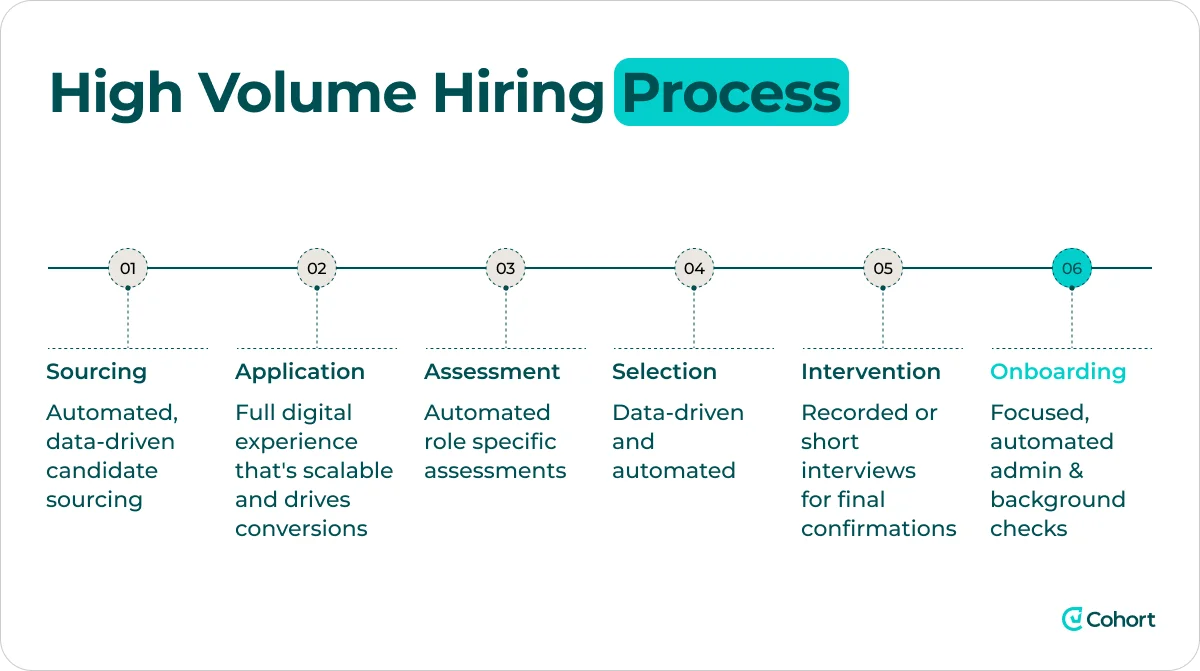
High volume hiring is common in industries like:
- Retail (e.g., holiday staff surges),
- Tech and software (e.g., scaling up engineering or DevOps teams for a new platform),
- IT services (e.g., hiring large remote IT support teams for enterprise clients),
- Hospitality (e.g., seasonal hotel or restaurant workers),
- Logistics and warehousing (e.g., fulfillment centers),
- Healthcare (e.g., support staff for hospitals or care homes),
- Contact centers (e.g., customer support agents).
Now, let’s explore the top 8 high-volume hiring strategies.
1. AI-powered high volume hiring strategy: Stop manual resume screening
Manually reviewing resumes takes too much time when you have hundreds of applications.
That’s where AI tools come in, as they can quickly go through all the resumes for you.
These tools sort and rank candidates by skills and experience, helping you hire faster, more accurately, and at lower cost.
💡 Why it works:
AI looks at past successful hires to find candidates with similar skills, experience, certifications, and qualities that match the role.
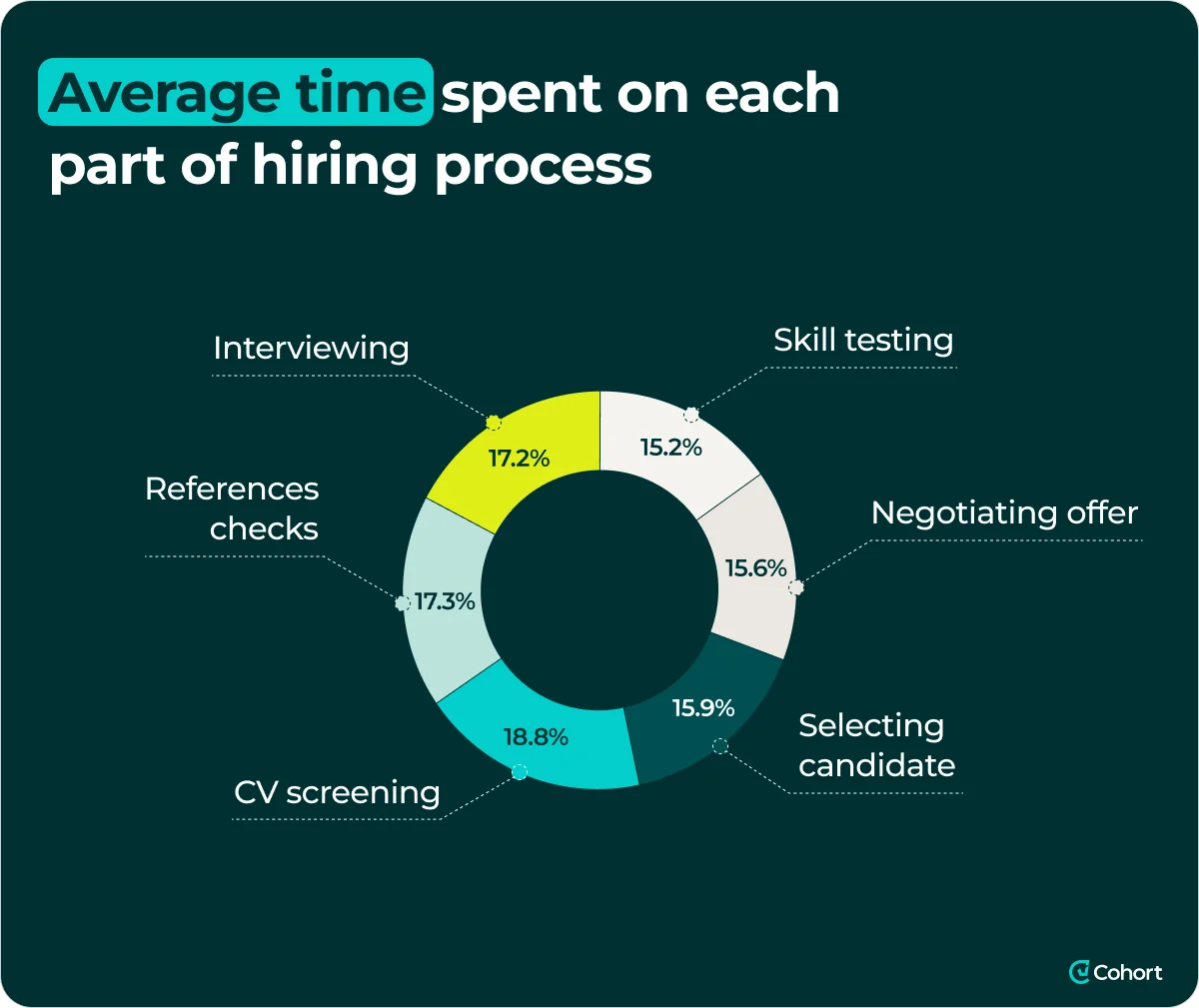
According to industry reports:
- AI can screen thousands of resumes in minutes, cutting time-to-fill by up to 50%.
- Companies using AI screening have seen cost-per-hire drop by 30%.
- 82% of companies use AI to screen resumes, while others use it for chatbots (40%), candidate assessments (64%), and even interviews (23%).
✅ How to implement it:
- Adopt AI resume parsers: Use tools that extract relevant data (skills, education, experience) and score candidates based on fit.
- Shortlist by fit score: Get an instant, ranked list of applicants that match your role requirements.
- Pair AI with human review: Let AI handle the sorting, then recruiters can focus on interviews and relationship-building.
📊 Proof in action:
73% of talent acquisition professionals believe AI will change how companies hire, and 37% are already using or testing generative AI in their recruitment process.
💡 Pro tip
Cohort AI’s Sally the Scout finds high-signal candidates across GitHub, LinkedIn, and more, so you review real skills, not just polished profiles.
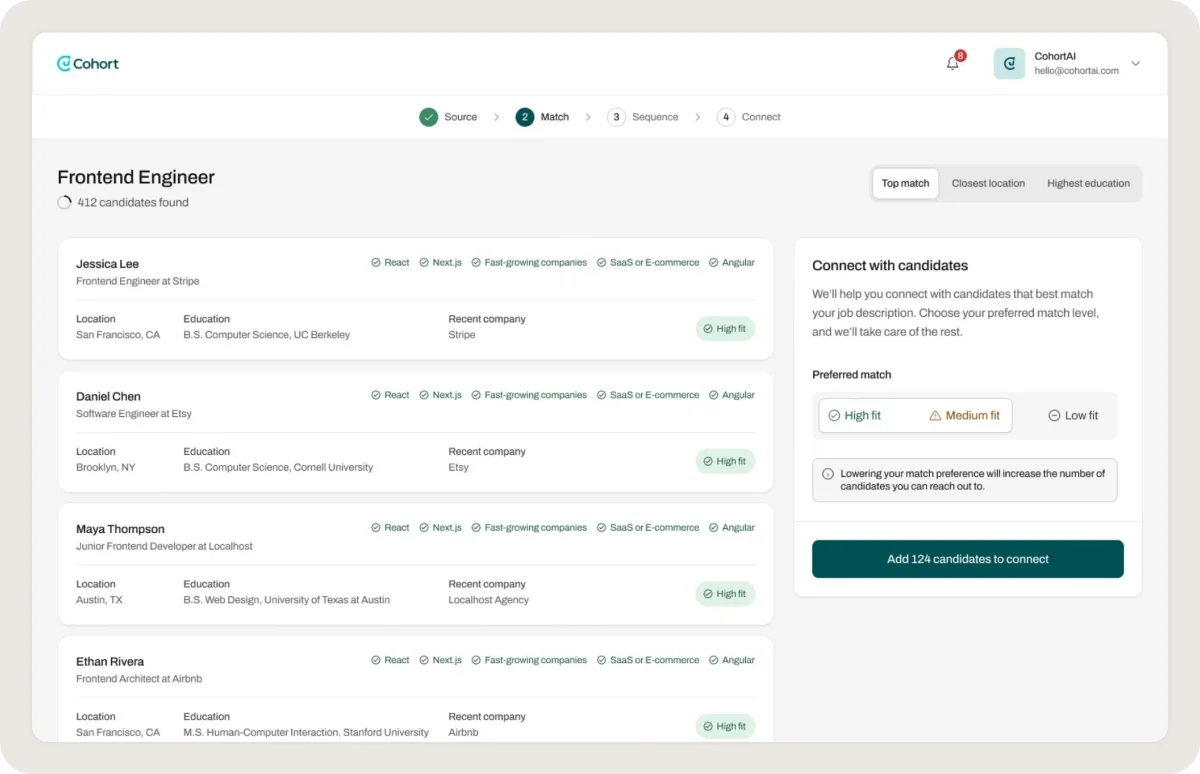
It delivers your top 3 candidates in days, not months, so your team moves faster without compromising on fit.
2. Automate hiring with early screening and interview scheduling
Once candidates enter the pipeline, repetitive admin tasks can slow everything down.
Automating early screening and scheduling keeps things moving and frees your team to focus on real conversations.
💡 Why it works:
Automated tools filter out unqualified applicants and eliminate back-and-forth emails.
This speeds up decision-making, keeps candidates engaged, and lightens the load for recruiters.
According to industry sources:
- Screening bots can disqualify poor fits instantly using skills tests, Q&As, or short video responses.
- Self-scheduling tools let candidates book interview slots on their own, and no emails are needed.
- Most chatbot engagement happens after hours, driving 66% of interactions, 60% of completed applications, and 48% of apply clicks.
✅ How to implement it:
- Set up screening bots: Use AI chatbots or recorded video questions to ask basic qualification questions (availability, skills, eligibility).
- Enable self-scheduling: Add tools that let candidates pick interview times directly from your team’s calendar.
- Automate follow-ups: Use triggers to send updates like “Thanks for applying” or “Next step: complete this test,” keeping candidates in the loop.
📊 Proof in action:
92% of hiring managers say they are using AI for screening resumes or pre-screening interviews.
💡 Pro tip
Cohort’s Pete the Prospector generates tailored outreach using your brand voice and each candidate’s public profile.
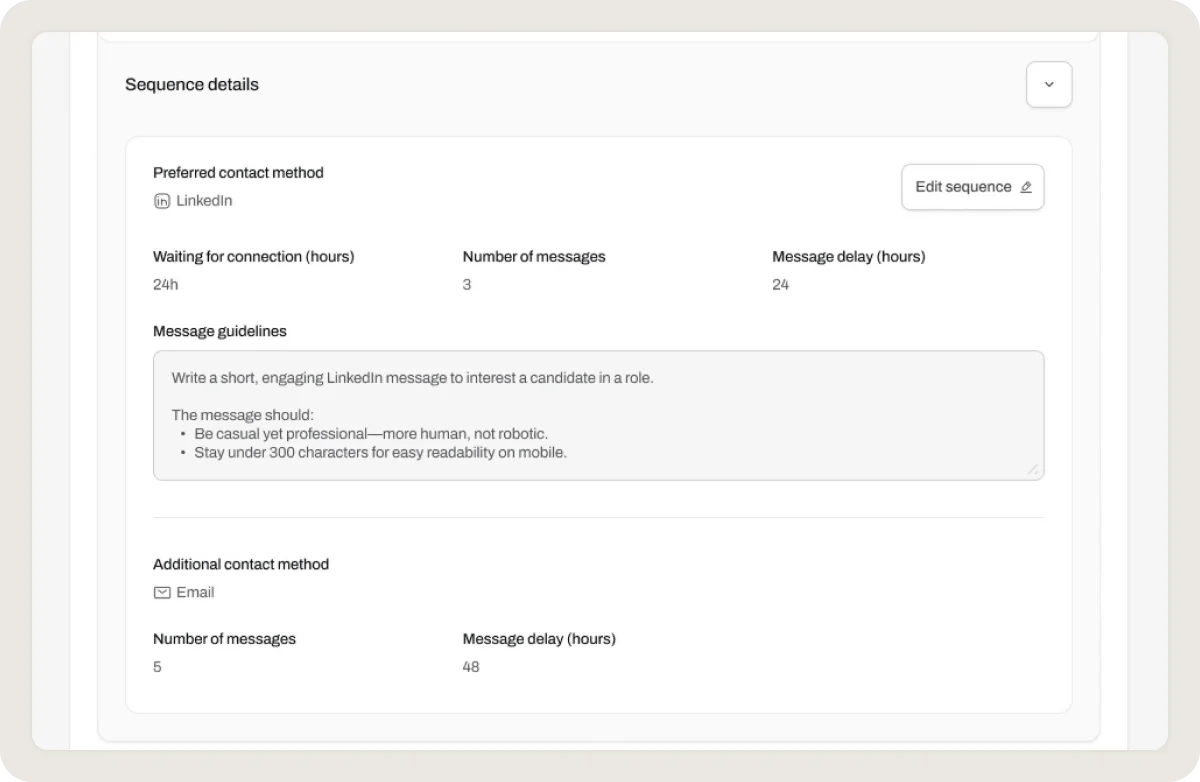
You get messages that feel personal and relevant, without spending hours crafting them manually.
3. Standardize and scale the interview process
When you're running dozens of interviews, consistency is key.
A standardized process helps reduce bias, speed up decisions, and make hiring more scalable, without sacrificing quality.
💡 Why it works:
Structured interviews are proven to be more reliable and fair than casual conversations.
When every candidate is asked the same job-specific questions and scored with the same rubric, hiring becomes faster and more objective.
Some of the benefits include:
- Structured interviews increase validity and reduce bias in hiring decisions.
- Asynchronous video interviews allow recruiters to review more candidates in less time.
- Interview panels or block scheduling help assess multiple candidates efficiently.
✅ How to implement it:
- Create structured guides: Ask all candidates the same questions linked to key job skills and score them using a shared rubric.
- Use interview blocks or panels: Schedule candidates back-to-back or involve multiple interviewers to speed up assessments.
- Try asynchronous video: Let candidates record answers to preset questions so recruiters can review them when it suits their schedule.
📊 Proof in action:
Studies show that structured interviews significantly improve hiring accuracy, and tools like video interviews help teams review high volumes without delays.
4. Hire candidates without losing the human touch
High-volume hiring involves hundreds of applicants, but that doesn’t mean it has to feel robotic.
The key is blending automation tools with personalization to keep candidates engaged and valued.
💡 Why it works:
Today’s candidates, especially hourly workers, prefer fast, friendly communication through texts and chat apps, and not just email. But they still want to feel seen.
According to a recent survey:
- Texting and messaging apps are now top communication channels for frontline and hourly job seekers.
- Simple personal touches in automated messages can boost candidate satisfaction and reduce dropouts.
✅ How to implement it:
- Use multi-channel outreach: Send quick updates via SMS, chat apps, or social DMs for confirmations and reminders.
- Automate status updates: Set up trigger-based messages (e.g., “Your test is scheduled” or “You’ve moved to the next round”) using your ATS.
- Add human check-ins: Schedule brief calls or personalized emails from recruiters at key points to show candidates you care.
📊 Proof in action:
32% of recruiters reported that candidates complained about a lack of personalized communication, showing the importance of adding human touches, even in high-volume hiring.
Pro tip:
💡 Cohort AI takes care of the busy work like sorting and screening, so your team has more time to talk to the right candidates.
It keeps the human touch by letting recruiters focus on real conversations while the AI quietly handles the rest in the background.
5. Reduce hiring bias with AI recruitment tools
In bulk recruitment, even small biases multiply fast across hundreds of hires.
Using structured and objective methods at every stage helps you to reduce hiring bias and improve hiring accuracy.
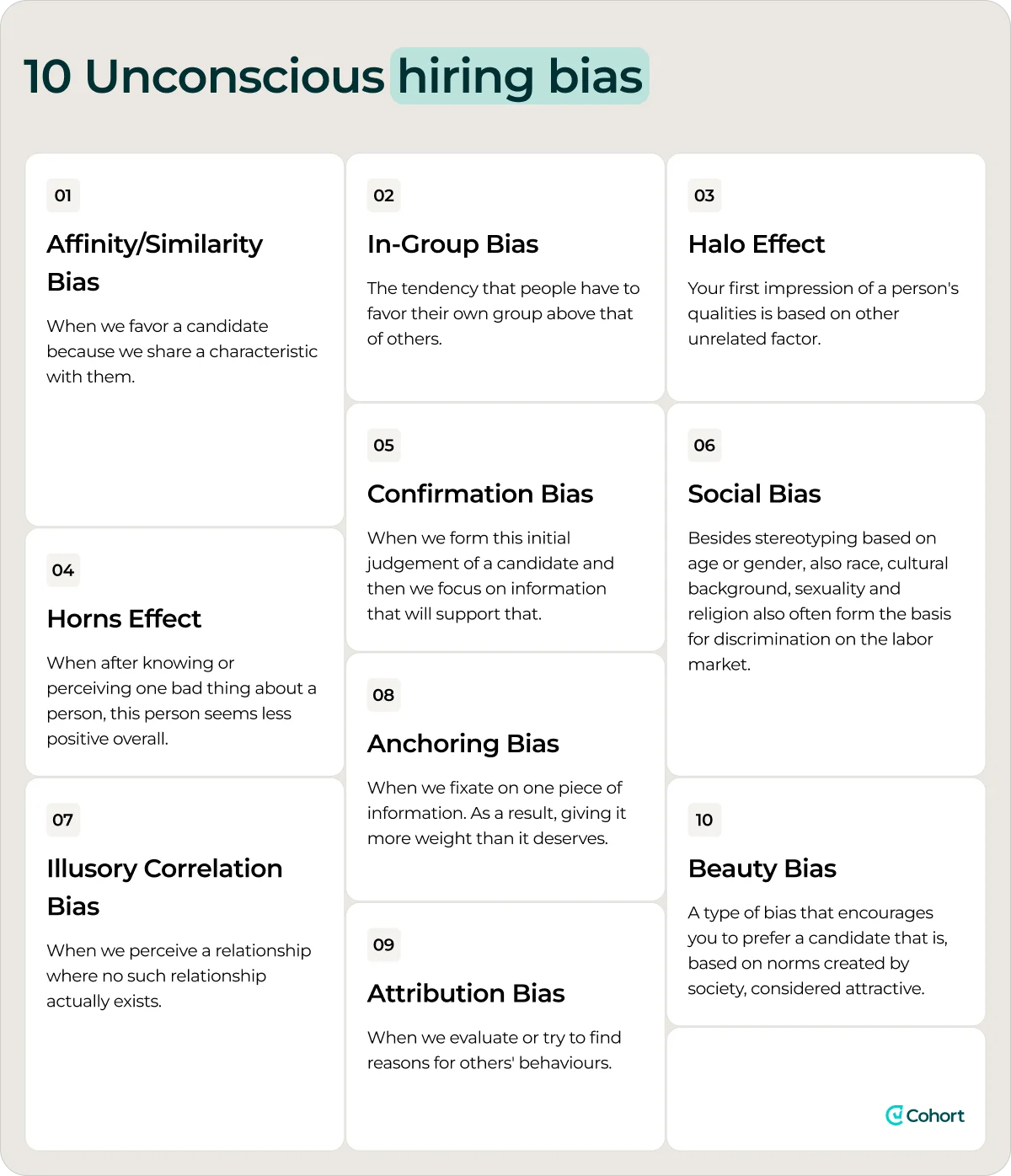
💡 Why it works:
Structured processes reduce subjectivity and keep every candidate focused on the same job-relevant criteria.
Here’s what works in practice:
- Structured interviews lead to better predictive validity and higher evaluator agreement.
- Blind resume screening removes names, photos, and schools to minimize unconscious bias.
- Validated skills and cognitive tests offer a fair, measurable way to compare candidates.
✅ How to implement it:
- Use structured interviews: Ask all candidates the same questions and score them with a defined rubric.
- Apply blind screening tools: Use AI systems that ignore personal details and focus on skills and experience.
- Add data-backed assessments: Use cognitive or skills tests that are validated for the role to ensure fair comparisons.
📊 Proof in action:
Two-thirds of hiring managers believe AI will be able to remove or mitigate cultural biases from the interview process.
6. High volume hiring strategy metrics that drive results
In high-volume hiring, data is your best guide.
The right metrics reveal what’s working, what’s not, and where to improve speed, efficiency, and quality.
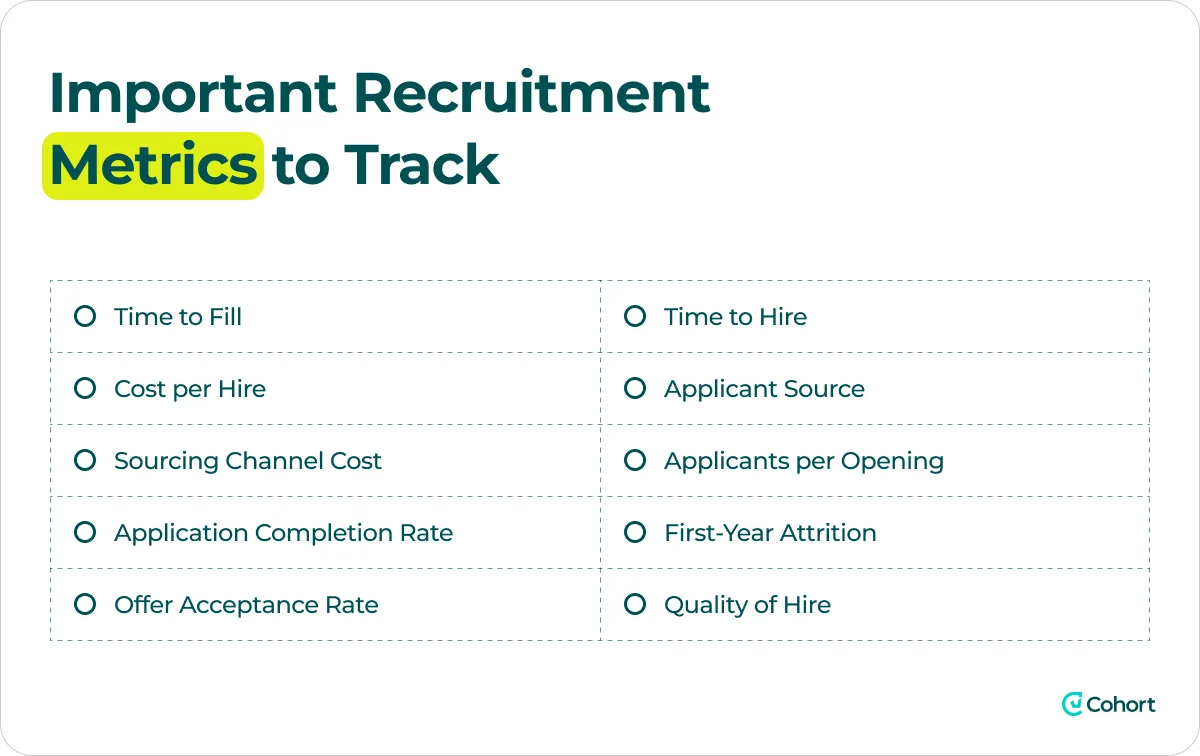
💡 Why it works:
Tracking key metrics helps you fix bottlenecks, reduce waste, and improve candidate experience, especially at scale.
Key hiring metrics to track include:
- Application completion and click-to-apply rates show how user-friendly your job postings are.
- Time-to-hire and interview-to-hire ratios reveal inefficiencies in your funnel.
- Retention and quality-of-hire metrics highlight if you're finding the right people for the job.
✅ How to implement it:
- Monitor application drop-offs: Track how many people start vs. finish your application to spot friction points.
- Watch time-to-hire closely: Aim to reduce days between application and offer, especially for bulk roles.
- Improve interview ratios: If it takes too many interviews to make a hire, review your screening process.
📊 Proof in action:
Six out of ten (61%) talent acquisition pros believe AI can improve how they measure quality of hire, showing its growing role in making hiring decisions more data-driven and effective.
💡 Pro tip
Cohort tracks how candidates move through your funnel and pinpoints where drop-offs or delays happen.
You get clear insight into what’s working and where to improve, backed by real-time sourcing data.
7. Use automation to improve candidate experience
Candidate experience shapes how people view your brand and impacts your hiring results.
In high-volume recruiting, a smooth and respectful journey keeps candidates engaged and reduces dropouts.
💡 Why it works:
A strong experience builds trust and prevents ghosting, while poor communication drives candidates away.
According to studies:
- Only 26% of job seekers rate their last hiring experience as “great.”
- 47% would drop out if communication is delayed or inconsistent.
- Clear updates, timely feedback, and thoughtful messaging improve satisfaction and completion rates.
✅ How to implement it:
- Automate status updates: Set up triggers to notify candidates when applications are received, interviews are scheduled, or decisions are made.
- Use chatbots for FAQs and prep tips: Help candidates feel informed by automating responses to common questions and sharing interview guidance.
- Automate but personalize: Use merge tags in automated messages to include names, roles, and custom sign-offs for a more human feel.
📊 Proof in action:
Letting candidates apply via text boosted NPS by 42%, and adding chatbot support raised it to 50%.
8. Improve hiring ROI with automation and post-hire data
If you're investing in high-volume hiring tools, you need to show results.
Using automation data and post-hire outcomes helps prove the value of your strategy and makes a strong case for continued investment.
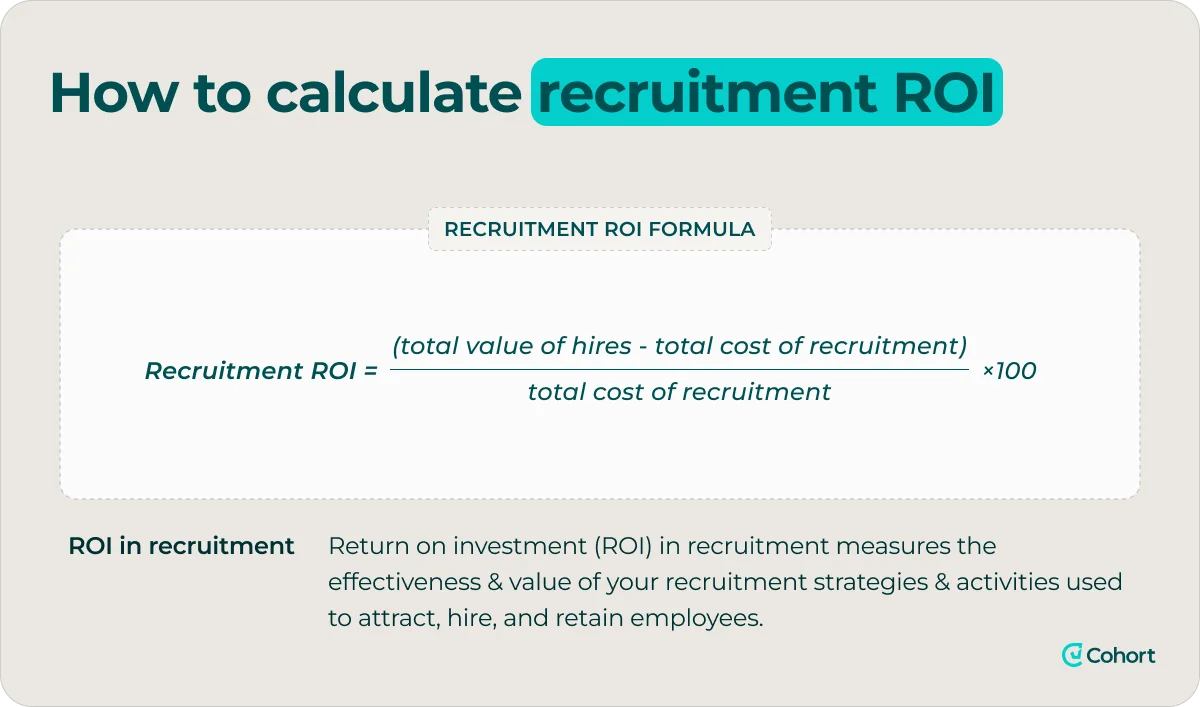
💡 Why it works:
Automation improves speed and efficiency, but tying it to post-hire success proves ROI.
Showing how your hiring process impacts retention, performance, and cost savings strengthens your business case.
Automation unlocks benefits like these:
- Automated scheduling and screening can save hundreds of recruiter hours.
- Faster hiring reduces overtime costs and prevents team burnout.
- Post-hire metrics like retention and satisfaction signal long-term hiring quality.
✅ How to implement it:
- Measure time and cost savings: Track how much time automation saves and estimate the payroll or operational value.
- Use post-hire performance data: Compare retention, probation pass rates, or satisfaction scores before and after automation.
- Show ROI by source or tool: Break down cost-per-hire by campaign or platform and link improvements to specific tech investments.
📊 Proof in action:
44% of organizations use AI for recruitment and talent acquisition, with AI tools cutting recruitment costs by up to 30% and reducing time-to-hire by as much as 50%.
Cohort AI: Powering faster, fairer high-volume hiring at scale
Ready to scale hiring without the chaos?
Cohort AI redefines high-volume recruitment by embedding generative AI and skills intelligence across every stage of the hiring journey, from sourcing to shortlisting.
We help high-volume hiring teams find top talent faster, reduce bias, and stay consistent at scale, without losing the human touch.
Our intelligent agents take care of the repetitive tasks so your team can focus on what matters most: making quality hires, fast.
Here’s how Cohort AI supports high-volume hiring:
- 🔍 Smarter sourcing at scale: Sally the Scout finds top candidates using real data, not just resumes or titles.
- ✉️ Personal outreach made easy: Pete the Prospector sends custom messages in your brand voice to boost replies.
- 📊 Fair ranking for every candidate: The Talent Graph scores based on skills, potential, and fit.
- 📬 Automatic follow-ups: Charlie the Closer handles replies and keeps candidates updated.
- ⚡ Quick, trusted shortlists: Get ready-to-review candidates matched to your role.
Ready to implement these high volume hiring strategies without sacrificing quality?
Book a demo and discover how AI-powered, skills-first hiring can help you scale recruitment with confidence.













